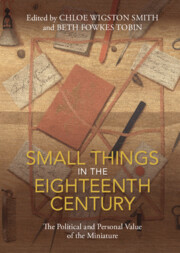Book contents
- Small Things in the Eighteenth Century
- Small Things in the Eighteenth Century
- Copyright page
- Contents
- Figures
- Notes on Contributors
- Acknowledgments
- Introduction
- Part I Reading Small Things
- Part II Small Things in Time and Space
- Part III Small Things at Hand
- 9 “We Bought a Guillotine Neatly Done in Bone”
- 10 “What Number?”
- 11 Two Men’s Leather Letter Cases
- 12 The Aesthetic of Smallness
- 13 “Small Gifts Foster Friendship”
- Part IV Small Things on the Move
- Afterword
- Select Bibliography
- Index
10 - “What Number?”
Reform, Authority, and Identity in Late Eighteenth-Century Military Buttons
from Part III - Small Things at Hand
Published online by Cambridge University Press: 29 September 2022
- Small Things in the Eighteenth Century
- Small Things in the Eighteenth Century
- Copyright page
- Contents
- Figures
- Notes on Contributors
- Acknowledgments
- Introduction
- Part I Reading Small Things
- Part II Small Things in Time and Space
- Part III Small Things at Hand
- 9 “We Bought a Guillotine Neatly Done in Bone”
- 10 “What Number?”
- 11 Two Men’s Leather Letter Cases
- 12 The Aesthetic of Smallness
- 13 “Small Gifts Foster Friendship”
- Part IV Small Things on the Move
- Afterword
- Select Bibliography
- Index
Summary
Marked military buttons were a distinct innovation introduced in the wake of the global Seven Years’ War that spread across the Atlantic world. On the smallest scale they physically embodied the reforms that characterize the period following that conflict. When considered at all, they are often used definitively by archaeologists to determine the presence of certain soldiers at specific sites. Although designed to function in this way, military buttons could not definitively identify personnel, given the realities of early modern military institutions, economic systems, and increasingly long distance imperial wars. As such, marked military buttons represent ideals of order and control rather than their actuality, exposing what military regulations and mandates alone obscure. This chapter explores the intention and reality of marked military buttons in the armies of France, Great Britain, and the new United States from the 1760s to the 1780s. These tiny artifacts reveal attempts to manifest systems of organization that, in fact, disclose their limitations to enact such systems, and thereby complicate their status as diagnostic artifacts in archaeological contexts.
Keywords
- Type
- Chapter
- Information
- Small Things in the Eighteenth CenturyThe Political and Personal Value of the Miniature, pp. 158 - 171Publisher: Cambridge University PressPrint publication year: 2022

